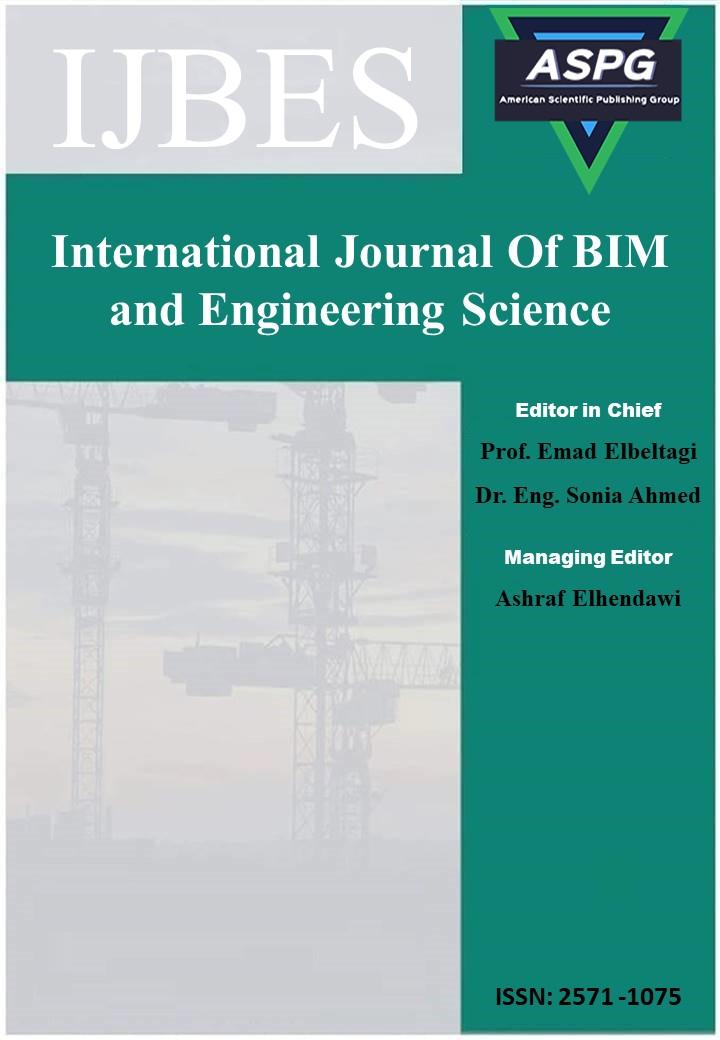

Volume 9 , Issue 1 , PP: 12-19, 2024 | Cite this article as | XML | Html | PDF | Full Length Article
Sophia Adum 1 * , Sonia Ahmed 2 , Alaa J. Kadi 3
Doi: https://doi.org/10.54216/IJBES.090102
This review highlights the importance of sustainability in the construction sector, focusing on residential and high-rise buildings. It aims to provide a framework for evaluating the environmental, social, and economic impact of these buildings and propose design options that enhance energy efficiency and reduce resource consumption. Using bibliometric and content analysis methods, the research identifies and quantifies relevant studies on sustainability in high-rise residential buildings and extracts key sustainable practices and principles for a comprehensive comparison of different sustainability assessment systems. Key findings indicate that implementing sustainable standards in residential towers significantly enhances energy efficiency, reduces harmful emissions, and promotes effective waste management. A case study of a tower in Basilea City demonstrated that these standards can lead to substantial energy consumption reductions through optimized design alternatives. The study concludes that integrating sustainability criteria into residential tower design and construction is essential for achieving long-term environmental, social, and economic benefits, emphasizing the need to adopt internationally recognized sustainability assessment systems.
Sustainability , Green buildings , Sustainable design , Sustainability assessment systems Sustainable practices
[1] Kadi AJ, Bakar AR, Isa CR, Salman H, Dhafir SA. The Effect of Innovation Barriers on Construction Firms’ Innovation Orientation. European Proceedings of Social and Behavioural Sciences. 2022; 12:145-160.
[2] Kadi AJ, Dhafir SA, Bakar AR, Isa CR. A Pilot Study on the Indirect Effect of Syrian Construction Firms’ Innovation Orientation on the Tourism Industry. In: Handbook of Technology Application in Tourism in Asia. Cham: Springer International Publishing; 2022. p. 645-667.
[3] Kadi AJ, Dhafir SA, Bakar AR, Isa CR. A Conceptual Framework for the Factors Affecting the Innovation Orientation of Syrian Construction Firms and the Indirect Effect on the Tourism Industry. In: Handbook of Technology Application in Tourism in Asia. Cham: Springer International Publishing; 2022. p. 629-644.
[4] Shaban MH, Elhendawi A. Building Information Modeling in Syria: Obstacles and Requirements for Implementation. International Journal of BIM and Engineering Science. 2018;1(1):42-64.
[5] Mendoza HA. Sustainable Practices and Challenges of Farm Destinations. International Journal of Academe and Industry Research. 2022;3(2):1-22.
[6] Pezzey J. Sustainable Development Concepts. World. 1992;1(1):45-52.
[7] Oliveira S, Marco E, Gething B. Energy-Efficient Design and Sustainable Development. In: Encyclopedia of Sustainability in Higher Education. Cham: Springer International Publishing; 2019. p. 523-532.
[8] Ali MM, Armstrong PJ. Overview of Sustainable Design Factors in High-Rise Buildings. In: Proceedings of the CTBUH 8th World Congress. Chicago, IL: CTBUH; 2008.
[9] Patil M, Boraste S, Minde P. A Comprehensive Review on Emerging Trends in Smart Green Building Technologies and Sustainable Materials. Materials Today: Proceedings. 2022;65:1813-1822.
[10] Kadid A, Alotaibi F, Alsalami J, Saleh M. Bibliometric Study of E-Government in Kuwait. International Journal of Information Technology and Knowledge Management. 2022;8(3):105-115.
[11] Kadi AJ. Biblio-Systematic Review of the Factors Affecting the Selection of Religious Translation Strategies. Journal of Translation Studies and Cultural Practices. 2022;6(2):201-215.
[12] Abrabba SA, Badarulzaman N, Mohamad D. Determining the Factors Affecting the Extent of Compliance with Residential Planning Standards: Case Study of Benghazi, Al-Fatah District, Libya. Planning Malaysia. 2022;20(2):141-155.
[13] Jefferson M. Sustainable Energy Development: Performance and Prospects. Renewable Energy. 2006;31(5):571-582.
[14] Calkins M. Materials for Sustainable Sites: A Complete Guide to the Evaluation, Selection, and Use of Sustainable Construction Materials. Hoboken, NJ: John Wiley & Sons; 2008.
[15] Khoja S, Scott RE, Casebeer AL, Mohsin M, Ishaq AF, Gilani S. Scope of Policy Issues in eHealth: Results from a Structured Literature Review. Journal of Medical Internet Research. 2012;14(1)
[16] Abrabba SA, Badarulzaman N, Mohamad D. A Biblio-Systematic Analysis of Factors Affecting the Compliance of Residential Planning Standards and Regulations: A Conceptual Framework. Civil Engineering and Architecture. 2021;9(3):646-655.
[17] Amrouni K, Arshah RA. A Bibliometric Analysis of the E-Government Studies with UTAUT. In: Proceedings of the FGIC 2nd Conference on Governance and Integrity. Kuantan, Malaysia: UMK Press; 2019. p. 189-195.
[18] Ahmed S, Dlask P, Selim O, Elhendawi A. BIM Performance Improvement Framework for Syrian AEC Companies. International Journal of BIM and Engineering Science. 2018;1(1):21-41.
[19] Lepkova N, Ustinovichius L, Zavadskas EK, Antucheviciene J, Zubrickiene I. BIM Implementation Maturity Level and Proposed Approach for the Upgrade in Lithuania. International Journal of BIM and Engineering Science. 2019;2(1):22-38.
[20] Raad L, Maya R, Dlask P. Incorporating BIM into the Academic Curricula of Faculties of Architecture within the Framework of Standards for Engineering Education. International Journal of BIM and Engineering Science. 2023;6(1):08-28.
[21] Saleh, F., Elhendawi, A., Darwish, A.S. and Farrell, P., 2024. A Framework for Leveraging the Incorporation of AI, BIM, and IoT to Achieve Smart Sustainable Cities. Journal of Intelligent Systems and Internet of Things, 11(2), pp.75-84.
[22] Saleh, F., Elhendawi, A., Darwish, A.S. and Farrell, P., 2024. An ICT-based Framework for Innovative Integration between BIM and Lean Practices Obtaining Smart Sustainable Cities. Fusion: Practice and Applications (FPA), 68.
[23] Elhendawi, A.I.N., 2018. Methodology for BIM Implementation in KSA in AEC Industry. Master of Science MSc in Construction Project Management), Edinburgh Napier University, UK.
[24] Elhendawi, A., Omar, H., Elbeltagi, E. and Smith, A., 2020. Practical approach for paving the way to motivate BIM non-users to adopt BIM. International Journal of BIM and Engineering Science, 2(2).
[25] Elhendawi, A., Smith, A. and Elbeltagi, E., 2019. Methodology for BIM implementation in the Kingdom of Saudi Arabia. International Journal of BIM and Engineering Science, 2(1).